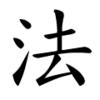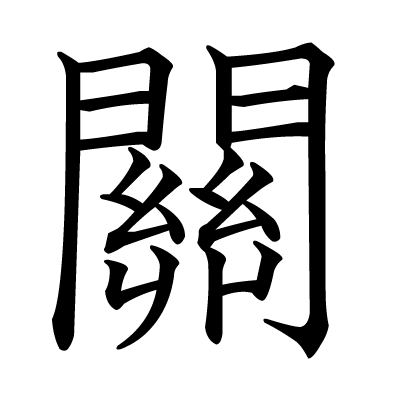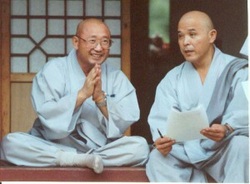On Magic, Attachments, and Righteous Indignation
Zen Master Wu Kwang
September 18, 2013
Question: I’ve heard stories where someone, after intensive sitting has an experience like they can see through the wall, they see a guy gardening outside, and they run to the Zen Master:“I can see though walls!” There are other versions like that where someone has an unusual perception and the Zen master’s reaction is to hit the student—konk on the head. So the student then feels, “Oh, I’m not really enlightened at all.” And goes back to sit in meditation some more. If your perception includes this miraculous saltshaker that can miraculously move three inches to the right, how is that different from an experience where suddenly you can see through a solid wall? Each one, if it happens is just an occurrence one day, Why does he get konked on the head by the Teacher?
Zen Master Wu Kwang: You would have to go ask the teacher.
Q: It’s a repeated pattern through a lot of stories.
ZMWK: But you see the way you put it is: yes, if that occurs then that’s just an occurrence, no different than the saltshaker – “Please pass the salt.” And “I can see through the wall!” That’s also just an occurrence. But usually what’s inferred in these kinds of stories when the monk comes running to the Zen Master – “Zen Master! I can see through walls! Isn’t that marvelous!” It is not just an occurrence. He is very attached to that unusual experience. That’s what’s sometimes referred to as you still have the stink of Zen, or still have the stink of something unusual. You’re clinging to that.
Just like if we sat down to eat and we each had a plain bowl of rice and there was no salt shaker there and you began to develop a negative attitude about the fact that we had to eat the rice with no salt. That would be problematic. Likewise, if someone becomes overly attached to some particular kind of occurrence, whatever it is, that becomes a hindrance. So the teacher meets the unusual with another unusual—pcchht!—a whack on the head. Then suddenly, “Oh, the floor is brown, the wall is white.” There, there is no attachment, there is just what is, occurrence by occurrence by occurrence. That is non-attachment living. There is one chapter in the book Dropping Ashes on the Buddha where Zen Master Seung Sahn says something like this—I’m paraphrasing it—“If enlightenment comes, wonderful; if enlightenment goes, that’s also wonderful.“ And then he says, “That very attitude is enlightenment.” That very attitude is different from some unusual experience that someone has and gets elated about or gets attached to. Not that there is anything wrong with those kinds of experiences. Those are just different kinds of experiences. But the basic attitude of “When something comes wonderful. When something goes, no problem.” That free-flowing attitude is an enlightened way of being, which is different from some particular experience.
So, yes, if you practice seriously and steadily for a long time, maybe you will have some unusual experiences too. Whether they be seeing through the wall or not, that’s not so important, but you will have some unusual experiences sometimes. But if you begin to look for those unusual experiences and can’t be as satisfied with the ordinariness of just sitting, not planning anything, not pushing anything away, not desiring anything in particular, but, just, as Suzuki Roshi says in his book Zen Mind, Beginner’s Mind, practicing with no gaining idea, then that becomes a problem. Everything is complete as it is. The cultivation of that way of being, you could say, is enlightened existence. Is that clear?
Q: Yes.
ZMWK: Anyone else?
Q: What if you are practicing and benefitting enormously from the practice and becoming attached to the practice and realize that . . ., I mean I’m realizing I don’t want to have that feeling of easy-come, easy-go, not having attachments. I’m fine with having attachments. I don’t want to become attached to seeing through walls, but I’m realizing I don’t have any problem with becoming attached to people, to certain principles.
ZMWK: That’s the same attitude. “I have no problem.” OK? When I was in Korea shortly after Zen Master Seung Sahn died I spent some time with an American monk who had been one of his attendants. He said that shortly before Zen Master Seung Sahn died, while in the hospital, this monk went to visit him, and asked, “How are you? Do you need anything?” Zen Master Seung Sahn looked up at him, and said “Everything no problem.” So if you’re fond of some people, and you don’t find any problem in that? That’s wonderful. That’s no-problem practicing.
Q: But what if then. . .
ZMWK: What if! You know, the function of the word “but” in sentences is to act as an eraser to everything that has gone before.
Q: No no no no no no . . .
ZMWK: No no no, I insist. Grammatically, it functions that way. And words are tricky. Words have their own kind of magic. We construct the world out of words. So if you say, “But what if,” that negates everything that went before.
Q: No, I’m not negating. I totally hear what you’re saying.
ZMWK: Well, let’s see. Go ahead.
Q: OK, just a little non-violent communication then: I hear you’re saying that if I don’t have a problem with having attachments to people and having attachments to principles, that’s no problem.
ZMWK: Yes.
Q: But what if something happens that threatens a person I care about or goes against a principle I’m attached to. Do I then have a problem?
ZMWK: Not necessarily.
Q: I wouldn’t say “no problem” at that point.
ZMWK: Of course not! Because if you did you would be attached to your own contentment.
Q: Excellent! OK.
ZMWK: I remember one time we had an international conference of the Kwan Um School of Zen in Singapore. The Singapore Zen Center, besides having Kwan Um people as speakers, invited some guest speakers. A Theravadin monk, I think he was Australian or British, gave a long talk about practice from his perspective, the Theravadin perspective, and when he got to the end of it the final stage was contentment. Zen Master Barbara Rhodes was sitting next to me and she leaned over and whispered in my ear, “Is that all? Contentment?” Because contentment means, just as you said, if I see someone getting killed over there, “No problem. I’m contented.” In its extreme form, there is no compassion in that view or attitude or practice. There is no room for righteous indignation when you see something wrong being done. Righteous indignation comes out of the perception that we are all interconnected, if something is being done that is not in accord with interconnected and one big family; if harm is being done, that will mobilize something in you to act out of compassion or even to act militantly. So no problem is one side of it, but if you look at nonviolent protest movements, Martin Luther King’s movement or Gandhi’s movement, or anyone else like that, you will see a certain degree of cultivation of “no problem” to be able to let someone spit in your face and not react violently to it. You need that as part of your ability to take a stand. But if you see something unjust being done and you say, “no problem, I’m keeping my contentment,” that’s not true Bodhisattva practice; that’s not the path of altruistic no-self. That’s “I want a contented self.” That’s not correct, in my opinion.
________________________
Know Your Characters: Bop
Know Your Characters: Kwon
On Magic, Attachments, and Righteous Indignation by Zen Master Wu Kwang
Three Poems by Ken Kessel, JDPSN






